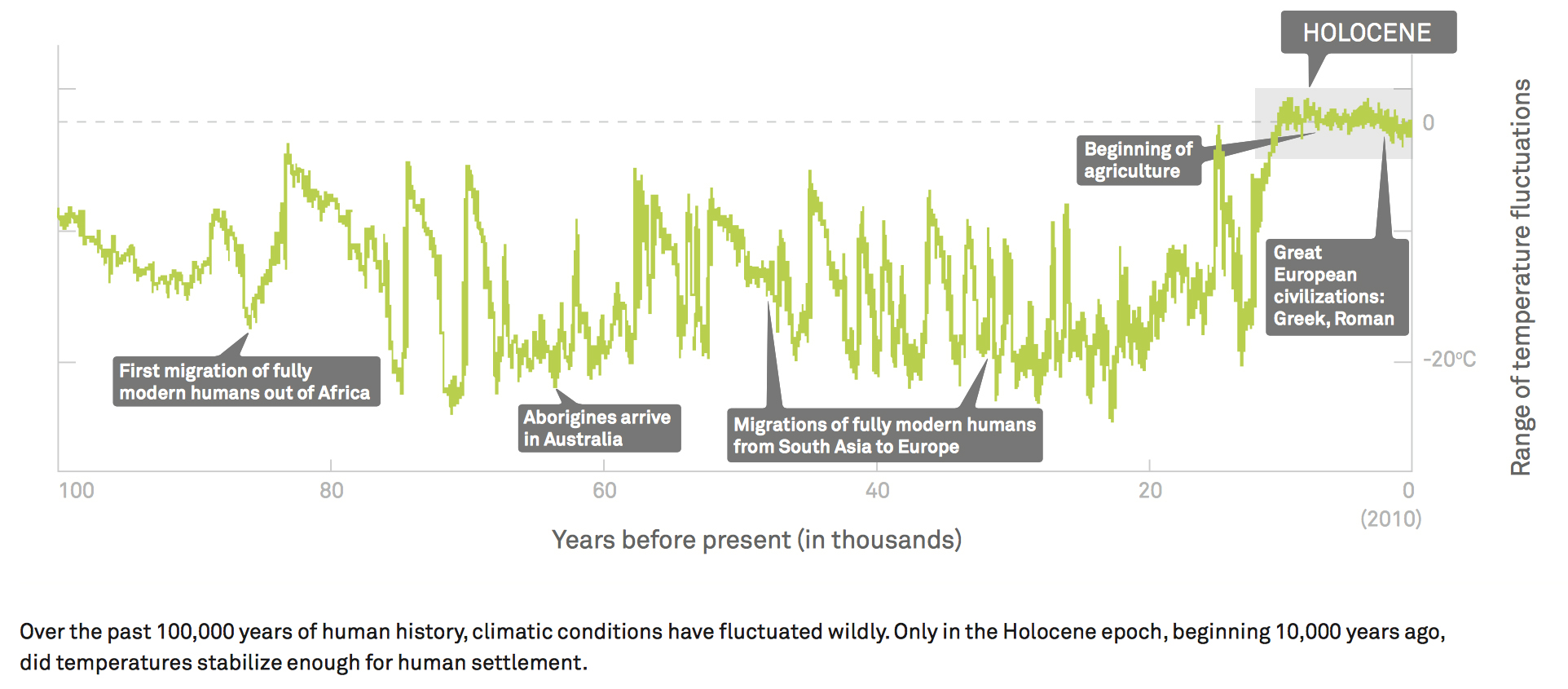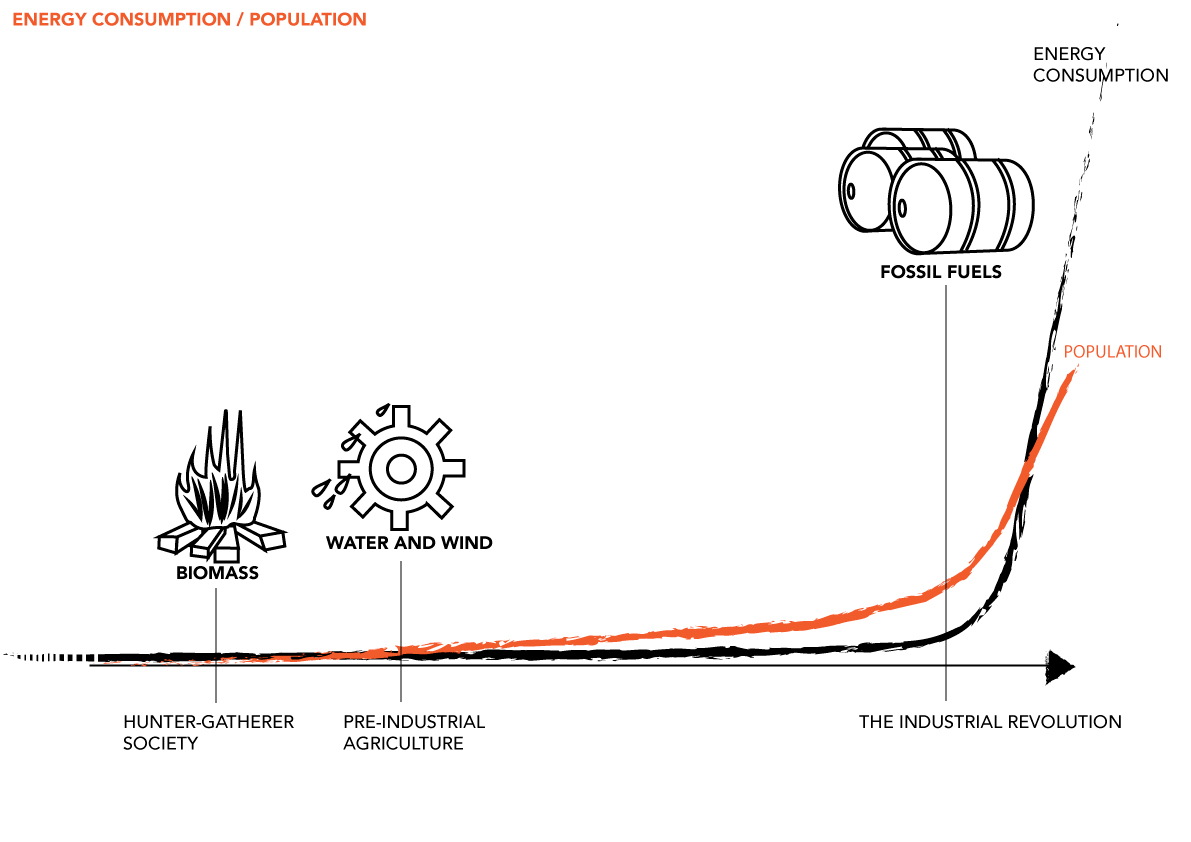Humanity’s energy history
Inge Røpke
In this section, we look at how people have gradually learned to utilise a greater number of energy sources, which has been an important factor in the establishment of the highly developed society we have today. But before we begin to discuss this energy story, we must first introduce some basic concepts and a few useful terms.
Several conditions must be met in order for humans to survive. For example, a sufficient amount of oxygen in the atmosphere, the availability of fresh water and, not least, access to energy, which is consumed in the form of food. The energy content of food comes from photosynthesis in plants, which involves converting solar radiation into chemical energy, which is stored in the biomass of plants.
People can consume this energy directly by eating plants or indirectly by eating herbivorous or carnivorous animals, all of which ultimately get their energy from the photosynthesis of plants. This is called the food chain. When an organism dies, bacteria and other organisms break it down so its biological components once again become part of the food chain. This cycle does not necessarily imply that all the biomass is recycled. For example, fossil fuel energy reserves have been formed because biomass from plants and animals has been stored underground for many millions of years. When humans started to mine for this stored biomass, you could say that they gained access to a very large store of solar energy (chemical energy resulting from photosynthesis) in a very convenient and easily usable form.
Because of the key importance of energy, it is important to examine how humans have used it over time. For this purpose, the concepts endosomatic and exosomatic energy consumption, which were introduced by the biologist, Alfred Lotka, in the early 20th century, are useful. Endosomatic energy consumption consists of the energy that one species absorbs through food and transforms into growth, movement and heat. All species have an endosomatic energy consumption, whereas until now, only humans have been able to exploit energy exosomatically. Exosomatic energy consumption refers to the use of energy for processes outside the body. The first time that humans were able to consume energy exosomatically was when they learned how to control fire. However, today, humans exploit a very large amount of energy exosomatically for innumerable activities and purposes such as transport, heating and street lighting.
Another useful concept for the story that follows is Human Energy Equivalent (HEE), which is used to denote the amount of endosomatic energy needed to keep a human being alive. The amount varies between individuals and between different climatic regions, but the two ecological economists, Michael Common and Sigrid Stagl, estimate that 10 megajoules per day is a good estimate of the average HEE.
The agricultural society
About 12,000 years ago, at the end of the last ice age, the climate warmed significantly and stabilised. During the geological period that followed, called the Holocene, conditions for humans became particularly favourable. The fluctuations in temperature became much smaller than they had been in the Pleistocene, which facilitated the establishment of long-term settlements and agriculture.
In contrast to the hunter-gatherer societies, agricultural societies were characterised by specialisation and hierarchy, while the organisation of the agricultural operations made it possible to obtain a significantly larger amount of biomass from a given area. Agricultural societies secured more energy by converting biomass to pulling power from animals and by using water and wind power. The energy consumption of agricultural societies is estimated at 3-4 HEE per person.
One might think that the increased energy surplus would improve living conditions, but for most, it was actually the reverse. Specialisation involved hard work and a short life for many, while the social surplus was used to construct magnificent structures, provide culture for the few and to wage war. In the transition from hunter-gatherer societies to agricultural societies, the latter were clearly the strongest, but hunter-gatherer societies survived in isolated pockets in some areas, and some even still exist today.

Agricultural operations involved significant changes to ecosystems as large areas were cleared of vegetation other than the intended crop. In some cases, farming communities gradually undermined their own livelihoods because the cultivation methods and the use of wood as raw material and fuel led to deforestation, salinisation and soil erosion, and because they did not find ways of solving these problems in time.
Industrial society (from around 1800)
The transition to the industrial society was, among other things, due to increasing resource problems in the agricultural society. In England, the use of timber had led to deforestation and a lack of wood as an energy source. For a long time, people had been aware of the potential of using coal, but it was only when a lack of wood became apparent that demand for coal increased. This stimulated technological development because the excavation of coal in deep mines required pumps to keep the water out and the operation of pumps stimulated the development of the steam engine, which required iron. The production of which demanded more coal. This spiral in technological development gradually led to coal becoming the primary source of energy in conjunction with key technologies related to the production of iron and the use of the steam engine.
With the discovery of oil and gas, industrialisation became linked to the internal combustion engine and then to the electric motor with the introduction of electrification. The use of fossil fuels combined with mechanisation and subsequently automation resulted in a significant increase in labour productivity. According to Common and Stagl, the average global exosomatic energy consumption in 1900 was approximately 14 HEE per person, which is as if every individual had 14 ‘energy slaves’ at their disposal. Since then, this figure has risen further and it is estimated that in 2000, on average, each human being had 19 ‘energy slaves’ at their disposal. However, this average was very unevenly distributed because, according to Common and Stagl, an American had about 93 ‘energy slaves’, while someone living in Bangladesh only had about 4 ‘energy slaves’ at their disposal.

Initially, it was primarily the manufacture of craft products that was mechanised, but later agricultural production also became industrialised. Human labour and horses were replaced by machines, and fossil fuels formed the basis for the production of fertilisers and pesticides to control weeds and pests. In combination with increasing meat production, mechanisation has resulted in agriculture now being a net consumer of energy, i.e. the amount of energy in the food that has been produced is less than the amount of energy used to produce it. This is in contrast to pre-industrial agriculture, where the yield expressed in energy was much greater than the energy used in the form of labour and draught animals. This surplus was due to photosynthesis, which is based on a generous gift in the form of solar energy. Even though modern agriculture also receives this gift, there is still no energy surplus. The advantage primarily lies in the significant increase in labour productivity, which is achieved by replacing labour with machines and fossil energy, while area productivity can often also be increased. In a way, one can say that today we are eating fossil fuels.
Next: The importance of the energy base